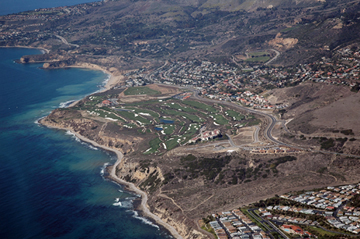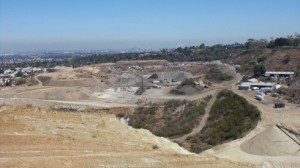Development Drama
By Victor J. Otten May 24, 2011Plans are in the works to replace some of the last open space on the Palos Verdes Peninsula with a private golf course and a massive housing complex. For a period of time it appeared that the equestrian community would come to the rescue, but now it seems that the group has splintered into two factions: those who still oppose the project and a smaller group of horse enthusiasts who are willing to go along with the proposed development and trade trail access and open space for funds toward the construction of new arenas as well as refurbishment of existing facilities.
That the stage is being set for a legal battle is unfortunate because the developer and the city of Rolling Hills Estates appear twilling to make concessions, and the parties seem close to an agreement that most community members would find acceptable. The Palos Verdes South Bay Group of the Angeles Chapter of Sierra Club has been closely monitoring the proposed development for some time, and it and other environmental groups are positioned to fight for concessions that will reduce environmental impacts related to the project and that will benefit the public at large such as more trails and open space.
The project site consists of approximately 228 acres and is currently the home of the existing Rolling Hills Country Club and the Chandler Palos Verdes Sand and Gravel Facility. The project applicant is proposing to build 114 new homes on portions of the existing golf course and expanding the golf course to an area currently being used as landfill. The facility will be private, and the developer is proposing to set aside only 3.9 acres as open space.
Environmental Impacts
In the summer of 2009, the city of Rolling Hills Estates published a Draft Environmental Impact Report (DEIR), which drew numerous comment letters. The Palos Verdes South Bay Group of the Angeles Chapter of Sierra Club expressed concern with several sections of the report, including global warming, cultural resources, density, water quality and changes to the general plan.
In June 2009 the Palos Verdes Peninsula Horsemen’s Association (PVPHA) submitted its own concerns, most of them addressing the fact that site development was contingent on removing 220 acres from the horse overlay zone, and the developer was refusing to incorporate a trail (Rolling Hills Estates was originally conceived as a community in which all neighborhoods would interconnect via a trail system). In addition, the PVPHA was concerned with errors in the DEIR related to biological resources and global warming analysis.
James Wells, PhD, PE, from the environmental firm Haley & Aldrich, submitted comments—pro bono—related to groundwater depletion and potential subsurface contamination. Since large sections of the golf course will be sitting atop a landfill, there are concerns with hydrology, geology and groundwater contamination.
Carl Lipo, a professor of Anthropology at California State University, Long Beach, submitted comments related to the cultural resources section of the DEIR. He did so at the encouragement of local resident Gary Johnson, who discovered a Native American site near the current golf course that dates back at least 3,000 years. Because Native American human remains had previously been found at the golf course, it seems likely that the whole area was part of one large community.
The city revised and re-circulated portions of the DEIR in response to the public comments. In September 2010, the city circulated the final EIR.
Discussion of Alternatives
CEQA Guidelines require that an EIR offer alternatives to the project or its location that could avoid or substantially lessen one or more of the significant environmental impacts while still accomplishing most of the project’s basic objectives. The EIR concluded that the “no project” alternative was not the best environmental alternative, primarily due to long-term air quality issues related to the current use of the site for landfill.
Significantly, the EIR concludes that Alternative 2—Development Consistent with Existing General Plan Designations—is the environmentally superior course. This option—25 homes, each on a one-acre lot—would have the least impact on existing homes and residents. This alternative is exactly what the equestrian community wanted in the first place.
Starting in October 2010, a few members of the equestrian community began working with project manager Mike Cope on environmental mitigation measures. Cope and, reportedly, the Chandler family, which has deep roots in the community, seemed willing to work with the equestrians.
On March 8, a Joint Adjourned Park & Activities Commission and Special Equestrian Committee Workshop was held, including a presentation by the PVPHA and Cope regarding equestrian mitigation measures related to the proposed project. During the presentation, the public was informed that:
1. The project applicant has committed to spending up to $1,000,000 to improve existing equestrian facilities in the city of Rolling Hills Estates in exchange for the riding community’s support for the project. (The commitment was qualified, however, by the stipulation that the city provide matching funds, for a total of $2 million.)
2. Funding for the equestrian projects by the developer would start once all of the approvals for the project were granted.
3. The PVPHA presented a list of 6 items that the project applicant is considering. They include improvements to existing equestrian facilities, including Ernie Howlett Park, Dapplegray Park, Peppertree Park, Rockbluff Park, Chandler Park and existing trail rehab.
4. The city has issued a policy statement that it will earmark $1 million in Quimby funds—essentially a fee the state charges a developer—for reinvestment into local parks and rec.
5. The costs being spent by the project applicant on architects, contractors and other professionals to evaluate the feasibility of the six proposed projects, is coming out of the $1,000,000 commitment.
The major problem with the proposed deal is that it only benefits some equestrians—in fact, many members of the equestrian community do not support the proposed mitigation measures. While proponents have stated that some of the money will be spent rehabilitating existing trails, it isn’t clear how much. In the absence of a specific sum, it seems unlikely there will be money left for trail upgrades after the building costs associated with new and existing equestrian facilities. For example, costs associated with the improvements to Ernie Howlett Riding Arena alone are estimated at just under $1.2 million. Moreover, because of engineering difficulties associated with building on a landfill, the cost will likely exceed the estimate.
The equestrians only represent a small percentage of people who utilize the trails on the Palos Verdes Peninsula. The environmental impacts associated with this project are huge, and any mitigation should benefit the community as a whole.
As indicated above, the EIR concludes that Alternative 2—Development Consistent with Existing General Plan Designations—is the environmentally superior alternative. Since this is what the equestrians stated that they wanted in their comment letters to the DEIR, it is difficult to understand why the same equestrians have decided to opt for money rather that supporting the conclusion of the EIR.
Yet there are some benefits to the proposed development. First, the current landfill use of the project site is unsightly, environmentally unsound and brings large, rumbling trucks that add to noise, pollution and road wear on a daily basis. In addition, the project will generate revenue for the area in the way of Quimby funds, taxes and jobs—things that help the entire community. Most importantly, the developer has indicated a willingness to work with local authorities to lessen the environmental impacts associated with the project. While it remains to be seen how much the developer is willing to compromise on certain aspects of the project, the environmentalists should not close the door on discussions related to supporting the project under the right circumstances.
The environmentalists, however, don’t appear ready to cede control of the future of the project to a small group of equestrians, and to that end, the threat of confrontation looms. The next phase of the approval process for the project will be public hearings before the planning commission, set to start in April. If the project is approved by the planning commission, it’ll go before the city council.
If the project is approved, the only recourse for opponents is via legal remedies, including, conceivably, a challenge under the California Environmental Act. Interested parties are urged to attend the public hearings and voice their opinions. A continued public hearing to discuss the proposed project will be held before the Rolling Hills Estates Planning Commission on April 4, at 7:30 p.m. in the Rolling Hills Estates council chamber, at 4045 Palos Verdes Drive North. Documents related to the project can be found at the city’s Web site, www.ci.rolling-hills-estates.ca.us. For additional information regarding future public hearings on this project, send your contact information to vic@ottenandjoyce.com.
Vic Otten is an equestrian and an attorney with the environmental law firm of Otten & Joyce.
Short URL: https://theequestriannews.com/?p=1514





